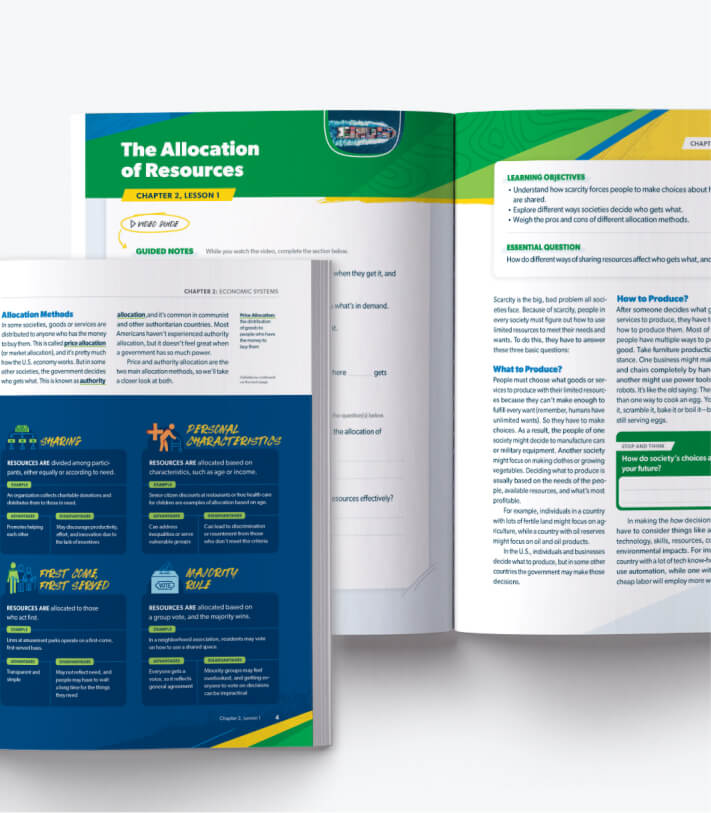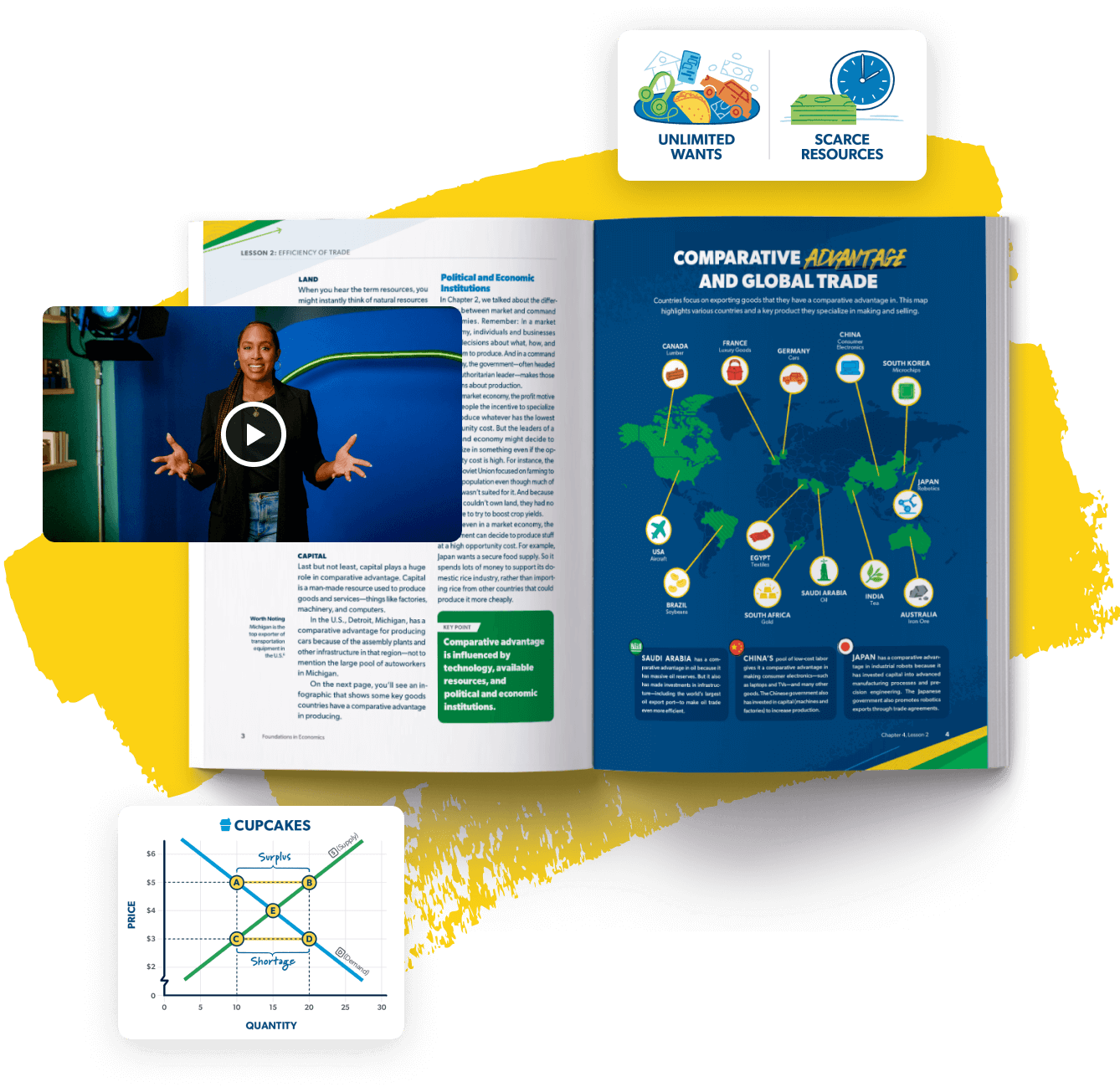

Now you can make economics feel real and relevant while meeting state and national standards. With 11 chapters and 49 lessons, this course makes it easy for students to learn how economic principles apply to real-life situations.


Our material is interactive, practical and relatable, ensuring students retain what they’ve learned long after graduation. Plus, it’s accessible and inclusive for all learning levels and backgrounds.

Engaging Video Lessons

Easy-to-Understand Infographics

Hands-On Activities

Real-World Application

With our turnkey curriculum, teachers can skip the planning and prep work. It’s consistent and structured, making it easy to stay on track.


Fully Digital
Activities

45-, 90- and 180-Day
Pacing Guides

Time Efficient
Autograding

Multiple LMS
Delivery Options
Get More Details
Curriculum presale begins in the summer of 2025, followed by the launch in January 2026!
We're Here to Help
Get tools and support to help you win in the classroom.
-

Curriculum Support and Training
-

Help Center
-

Professional Development

Table of Contents
Chapter and Lesson titles subject to change, topics are final.
-
Chapter 1: Fundamentals of Economics
-
Lays the foundation for understanding how the economy works by exploring scarcity, opportunity cost, incentives, and the value of wise decision-making. Highlights the role of self-interest, utility, and long-run growth in shaping economic choices—from individuals to entire nations.
- Lesson 1: Why Economics Matters
- Lesson 2: Unlimited Wants, Scarce Resources
- Lesson 3: Decision-Making and Choice
- Lesson 4: Efficiency
- Lesson 5: Incentives
-
Chapter 2: Economic Systems
-
Explores how societies answer the basic economic questions through different systems—market, command, mixed, and traditional. Highlights the role of property rights, government involvement, and competition in shaping economic freedom and how goods and services are distributed.
- Lesson 1: The Allocation of Resources
- Lesson 2: Market vs. Command Economies
- Lesson 3: Property Rights
- Lesson 4: The Free Enterprise System
-
Chapter 3: Supply and Demand
-
Unpacks the laws of supply and demand, showing how prices are set in the market and how shortages and surpluses are resolved. Connects prices to decision-making, coordination, and incentives—and explains how wages are determined in the labor market.
- Lesson 1: Demand
- Lesson 2: Supply
- Lesson 3: Equilibrium
- Lesson 4: Prices
- Lesson 5: The Labor Market
-
Chapter 4: Trade
-
Explores how specialization and comparative advantage make trade more efficient. Breaks down the benefits and challenges of globalization, and the role of tariffs, quotas, and exchange rates in shaping international trade.
- Lesson 1: Comparative Advantage and Specialization
- Lesson 2: Efficiency of Trade
- Lesson 3: Globalization
- Lesson 4: Trade Barriers
-
Chapter 5: Navigating the Market
-
Explores how governments step in when markets don’t work perfectly—through public goods, subsidies, regulations, and price controls. Highlights how externalities and interest rates shape individual choices and long-term outcomes.
- Lesson 1: Externalities, Subsidies, and Regulations
- Lesson 2: Public Goods and Services
- Lesson 3: Price Controls
- Lesson 4: Market for Loanable Funds
-
Chapter 6: Individuals and Firms
-
Breaks down the different types of businesses structures, how they compete, and what drives their decisions. Explains the role of entrepreneurs, the costs of production, and how firms grow by weighing risks and rewards.
- Lesson 1: Market Structures
- Lesson 2: Factors of Production
- Lesson 3: Production on the Margin
- Lesson 4: Business Types
- Lesson 5: Entrepreneurs
-
Chapter 7: Economic Growth
-
Spotlights what drives long-term growth and how economists measure it. Focuses on GDP, the circular flow model, employment trends, and what influences standard of living and national prosperity.
- Lesson 1: Fundamentals of Economic Development
- Lesson 2: Circular Flow Model
- Lesson 3: Measuring Growth (GDP)
- Lesson 4: Standards of Living
- Lesson 5: Employment Trends
-
Chapter 8: Money and Banking
-
Explores what money is, how banking works, and why inflation matters. Covers the history of currency, how the Federal Reserve manages the money supply, and how monetary policy influences interest rates and affects broader economic goals.
- Lesson 1: History of Money
- Lesson 2: Banking System
- Lesson 3: Inflation
- Lesson 4: Monetary Policy
-
Chapter 9: Fiscal Policy
-
Breaks down how the government taxes, spends, and borrows to steer the economy. Explains the federal budget, the national debt, and how fiscal policy aims to control inflation, reduce unemployment, and support growth—while showing how political incentives shape these decisions.
- Lesson 1: Federal Budget and Spending
- Lesson 2: Taxes
- Lesson 3: Applying Fiscal Policy
- Lesson 4: Political Economy
-
Chapter 10: Short-Run Macro
-
Explores how economies grow, slow down, and recover—plus how unemployment, inflation, and government responses fit into the big picture. Unpacks the business cycle, short- versus long-run thinking, and competing economic philosophies.
- Lesson 1: Business Cycle Theory
- Lesson 2: Unemployment
- Lesson 3: Short-Run vs. Long-Run Economics
- Lesson 4: Economic Philosophies
-
Chapter 11: Personal Economics
-
Applies the key economic principles to personal finance by highlighting budgeting, saving, debt, housing, insurance, and investing. Spotlights how to take control of money with confidence and intentionality.
- Lesson 1: Intentionality With Money
- Lesson 2: Living Debt-Free
- Lesson 3: College and Career Planning
- Lesson 4: Real Estate and Insurance
- Lesson 5: Investing and Your Future
Frequently Asked Questions
-
How do I get a quote?
-
Simply fill out the form above and our team will reach out. You can then request a quote and our team will provide you with one based on your class size and student needs.
-
Does Foundations in Economics support online or virtual learning?
-
Yes! Foundations in Economics is available in a fully digital option, as well as a print and streaming option. No matter what delivery method you choose, a printed Teachers Guide is availabe for purchase.
-
How long does it take to teach Foundations in Economics?
-
Foundations in Economics is designed as a semester-long course with stand-alone chapters. We provide you with flexible pacing guides that you can choose from, but if you don’t need a full semester course, the stand-alone chapters allow you to make the course fit your schedule—not the other way around.

